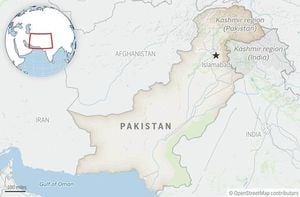On September 3, 2025, a pivotal decision by India’s Goods and Services Tax (GST) Council sent ripples through the nation’s insurance sector and beyond. In a move hailed as part of Prime Minister Narendra Modi’s “next-generation” GST reforms, the Council—chaired by Union Finance Minister Nirmala Sitharaman—announced a sweeping exemption of GST on individual life and health insurance premiums, as well as on reinsurance costs. The reforms, bundled as GST 2.0 and first unveiled in Modi’s Independence Day speech, aim to simplify India’s indirect tax structure, boost consumption, and make insurance more affordable for millions. The new rules are set to take effect from September 22, 2025, and have already triggered significant reactions in financial markets and among industry stakeholders, according to reporting from The Economic Times, CNBC-TV18, and BloombergQuint.
For years, India’s insurance penetration has lagged behind global averages, with many households citing high costs as a barrier to entry. Until now, health and life insurance policies attracted a hefty 18% GST—an added burden that often deterred middle-class families and first-time buyers. The new exemption is expected to trim health insurance premiums by around 15%, according to HSBC Securities and Capital Markets (India), making policies more accessible and aligning with the government’s financial inclusion goals. “Rationalising GST on insurance is a progressive step that will enhance affordability and strengthen social security. Exempting premiums will make health and life cover more accessible, especially for the middle class. It shall lower the cost of insurance and will marginally increase the disposable income,” The Economic Times reported from industry analysis.
But as with any major policy overhaul, there’s a catch—or several. While policyholders stand to benefit from cheaper premiums, insurance companies now face a new set of challenges. The exemption means insurers can no longer claim Input Tax Credit (ITC) on their operating expenses, such as commissions, reinsurance, and claims processing. As CNBC-TV18 explained, “Insurers incur various costs like reinsurance, commissions, and claims processing. With GST exempted, insurers cannot claim Input Tax Credit, increasing their net cost of operations. This could impact profitability or lead to higher policy costs in the future.”
Brokerage firm CLSA put it bluntly: “To protect their profitability and manage this change, insurers will implement price hikes.” Health insurers, they estimate, may raise prices between 3% to 4%, while life insurers might need hikes of 1% to 3%—but even with these adjustments, policyholders are still expected to come out ahead, since they’ll no longer pay the 18% GST. Morgan Stanley echoed this cautious optimism, noting, “In absence of relief to insurers, they might be required to raise premiums, thereby reducing net cost benefit to customers.”
The GST Council’s reforms go beyond just insurance. As part of GST 2.0, the government has reduced the number of GST slabs from four to two—5% and 18%—while retaining special rates for select items. The goal, according to Modi’s August 15 speech, is to create a more streamlined and equitable tax system that encourages spending and economic growth. The Group of Ministers, which includes state finance ministers, met on September 3 to finalize these proposals. The insurance sector, however, has taken center stage in public discourse, given its direct impact on household finances and stock markets alike.
The immediate market reaction was dramatic. On September 4, shares of major life and health insurers soared. Star Health and Allied Insurance Co. jumped 9.3%, ICICI Lombard GIC rose as much as 5.4%, and Life Insurance Corporation of India gained 4.5%. HDFC Life’s shares were up over 5% in the past month, with both HDFC Life and SBI Life showing impressive gains of 25% to 30% for the year, as per CNBC-TV18 and BloombergQuint. Niva Bupa’s shares hovered just above their IPO price of ₹74 apiece. The excitement was palpable, but so too was a sense of caution about what comes next.
Finance Minister Nirmala Sitharaman clarified the scope of the exemption: “Exemption of GST on all individual life insurance policies, whether term life, ULIP, or endowment policies, and reinsurance.” Individual health insurance policies, including family floater and senior citizen plans, are all covered by the new rules. The GST on reinsurance—a cost that comprises 30–35% of an insurer’s base—has also been exempted, though most individual policies are not reinsured. The effect? Policies could get cheaper for policyholders by as much as 15%, if insurers pass on the full benefit. But for insurers, every policy could increase costs by 5% to 7% due to the loss of ITC, according to CNBC-TV18.
Industry analysts are divided on how the reforms will play out over time. Jefferies, for instance, sees the GST exemption as having a “manageable impact,” with the potential for increased sales of high-margin protection and riders to help offset higher operating costs. UBS and CLSA both note that insurers may need to raise prices by 1% to 4% to protect profitability, but that the reforms should ultimately drive insurance penetration higher. “The impact of the exemption will be highest on term and health insurance, making them more affordable to the masses, whereas traditional life or ULIP products may see only limited savings due to higher embedded costs and investment portions,” Jignesh Ghelani, Partner at Dhruva Advisors, told The Economic Times.
Still, the reforms are not without risk. The so-called “inverted duty structure”—where input costs are taxed but the final product is exempt—remains unresolved, potentially leading to long-term margin pressures for insurers. “The effectiveness of the rate change will depend on whether key input services such as commissions and reinsurance also receive an exempt status, as this would prevent blockage of input tax credit,” said Mahesh Jaisingh, Partner at Deloitte India, as quoted by The Economic Times.
For policyholders, especially those in the middle class and underserved segments, the reforms could be a game-changer. Lower premiums mean greater access to health and life coverage, supporting broader social security and financial inclusion objectives. For insurers, the next few months will be a balancing act—adjusting pricing, maintaining profitability, and navigating the new tax landscape. Some may absorb costs in the short term to capture market share; others may pass on more of the burden to consumers.
As the GST 2.0 reforms roll out on September 22, all eyes will be on how insurance companies respond and whether the government provides further relief on input taxes. The hope—shared by policymakers, insurers, and consumers alike—is that the changes will spark a new era of growth and protection for India’s vast and diverse population, even if the road ahead is dotted with challenges and tough choices.




